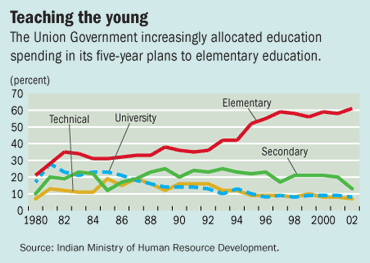India's elite educational institutions have been producing first-rate scientists, engineers, and managers who helped India's information technology sector take off during the 1990s.
Far less visible is the more recent, quiet revolution in India's elementary education that, if successful, will equip an entire younger generation with skills to improve productivity and reduce the burden of disease, high birth rates, hunger, and poverty, while changing societal attitudes toward gender, caste, tribe, and disability.
What India has accomplished is no small feat -- especially given that its population grew from about 840 million to nearly one billion between 1991 and 2001, with the number of children between the age of 6 to 14 rising by 35 million to 205 million.
Over roughly the same period, the gross enrolment ratio (GER) in primary education (grades 1) rose from 82 per cent to 95 per cent, and in upper primary education (grades 6) from 54 per cent to 61 per cent (see table).
Available government data suggest that in that age group, the number of children not in school fell sharply from about 60 million in the early 1990s to 25 million in 2002, and this decline is continuing. While specific numbers in such a large federal system may be viewed with caution, the rough magnitude of the progress appears to be in little doubt.
|
Educating the masses After primary education was made a national priority, enrolment --especially for girls -- showed dramatic gains. | ||
|
|
1993
|
2002
|
|
(percent) | ||
|
Primary education (grades 1-5 for ages 6-11) |
|
|
|
(percent of GDP) | ||
|
Total public spending on education and training |
3.6 |
4.1 |
|
(dollars) | ||
|
Public spending per elementary student |
|
|
|
Sources: Data from India's Ministries of Human Resource Development and Finance; and World Bank estimates. | ||
The expansion of primary education -- driven by major policy changes along with higher demand for schooling stemming from economic growth and globalisation -- took hold all across India. Historically, India's southern and western states had always been far ahead in education of the large northern states, which accounted for most of the out-of-school children.
Over the past decade, however, many poorly performing states began to make real overall advances -- the primary GERs in Rajasthan, Uttar Pradesh, and Madhya Pradesh were well over 90 per cent, although the ratio remained at 74 per cent in Bihar.
The southern states, the states on the east and west coasts, the Himalayan states, and the northeastern states -- except for Assam and Nagaland -- were either approaching universal primary enrolment or had already achieved it.
Increased access for girls and children of disadvantaged groups accounted for much of the improvement. The overall GER for girls was 92 per cent and over 95 per cent for children of scheduled castes and scheduled tribes -- the most disadvantaged groups, which make up 18 and 9 per cent, respectively, of all primary school-age children.
Given the momentum built up over the years, India will, in all likelihood, meet the education Millennium Development Goal (MDG) of universal primary education -- which calls for all children of primary school age to participate in the school system and complete primary school. This article explores India's quiet revolution.
From elite to all
India's education development since Independence can be divided into three phases.
Phase 1: Educating the elite to build national capacity. From Independence in 1947 through 1986, education policy emphasised building national capacity for self-government and self-sufficiency through elite education. The states were mainly responsible for financing and providing education, which led to mixed results as commitment varied between states. Initially severely constrained, public spending for education rose from below 1 per cent of GDP in 1950 to 3.4 per cent in 1986.
Phase 2: Making primary education a national priority. In 1986, the Government of India (known as the Union Government) launched the landmark National Policy on Education, which resulted in a series of pilot projects on a large scale. Following the World Conference on Education for All in 1990 in Jomtien, Thailand, India opened up to external assistance for primary education.
The most extensive external partnership, involving the World Bank, the United Kingdom, the European Commission (EC), the Netherlands, and UNICEF, was the District Primary Education Program in 18 large states, covering about half of India's 600 districts with low female literacy rates.
The program created active partnerships between the government and civil society organisations and strengthened coordination in the areas of planning, training, and research. Financial management and procurement systems, procedures, and checks and balances have been put in place, making it possible to scale up in the next phase.
Between 1993 and 2002, total public spending on education rose steadily from 3.6 to 4.1 per cent of GDP, higher than the average spending of 3 per cent of GDP among low-income countries. Elementary education expenditure rose from 1.7 to 2.1 per cent of GDP, accounting for over 60 per cent of the growth in public expenditure on education in this period. As the economy grew about 6 per cent annually over this period, resources increased in both relative and absolute terms and spending per elementary student rose from $25 to $44 despite higher enrolment. The Union Government's share of total public expenditure on education rose to about 15 per cent, with the states covering the remainder (see chart).

Phase 3: Universalising elementary education.
In 2001, India launched the National Programme of Universal Elementary Education, known in Hindi as Sarva Shiksha Abhiyan (SSA), and amended its Constitution to make quality elementary education a fundamental right of every child. The program is designed so that by 2007, all children, including children with disabilities, will have completed primary schooling, and by 2010, upper primary schooling -- a much stiffer requirement than the MDG of universal completion of primary education by 2015.The SSA program combines centrally set targets and norms for planning and costing with decentralised management, bottom up planning, community mobilisation, and social audits. With the Union Government contributing 75 per cent and the states 25 per cent, SSA funds annual work plans submitted by states and districts to meet the targets.
To ensure that central funds are not used to substitute state spending, SSA obliges the states to maintain spending for elementary education in real terms at the 1999 level and to match growing central funds above this level. The expected incremental SSA cost of $3.5 billion for 2004 would add another 9 per cent per year to the total resources for elementary education. Three external partners (the World Bank, the United Kingdom, and the EC) contribute $1.05 billion to the Union Government's share.
SSA finances civil works, salaries for additional teachers, alternative schools in sparsely populated areas, bridge courses for dropouts, innovations, teacher training, school and teacher grants, and community-based organisations to provide on-site support. To tackle gender and social inequalities, SSA subsidises the cost of providing free textbooks to all girls and all students of scheduled castes and tribes, special facilities for girls (such as early childhood education centres for alternative sibling care and girls' toilets), and grants to districts to support students with disabilities.
SSA also funds a national component for capacity building, technical support, monitoring and evaluation, financial management, dissemination of good practices, and media campaigns.
The program is designed to emphasise participation, transparency, and public accountability. It requires that every state take a baseline household census of children to ascertain their age, gender, social, and education status. Once the Project Approval Board agrees to the states' and districts' annual work plans, funds are released to the states for implementation. The funds are overwhelmingly spent at the community level, and their sources and uses at the school level are required to be posted publicly.
Since its 2001 launch, SSA has focused its efforts -- with initial signs of success -- on enrolling children who have never enrolled and in bringing dropouts back to school, while at the same time taking in new age groups and improving the quality of educational inputs. SSA is complemented by another national program, the Mid-Day Meal Scheme, that provides daily school meals to all primary school students, thereby providing not only the needed nutrition but also incentives for poor children to enrol in and complete school.
SSA enjoys non-partisan political backing, as evidenced by major budget increases under both the present and previous Union Governments. The prime minister of India is the chair of SSA's National Mission, ensuring the highest-level attention.
Risks and challenges
As India has vastly expanded enrolment, it now needs to reduce high teacher and student absenteeism, lower repetition and dropout rates, and improve student achievement. In 2002, an early assessment of public school student achievement in grade five suggested huge differences within and across states.
India tends to reward rote learning, and there are no international benchmarks for judging education standards. At the national level, periodic assessments of student achievement are planned. It is vital that the test instruments be valid, reliable, and well designed. Participation in international comparative assessments should be used to improve and strengthen the technical capacity for measuring quality.
Some states are taking steps to focus on quality. Madhya Pradesh has a system of tracking each child's achievement in each subject for diagnosis, remedial education, and teacher training, and the results of state-wide examinations at the end of grades 5 and 8 are reported to the state legislature, putting the focus on learning outcomes.
Meanwhile, sustaining improvement in the teaching and learning process, increasing the time-on-tasks, and devising specific strategies to address special needs are essential. Multigrade classrooms, common in rural areas, require far more learning materials and teachers than are currently provided. With 17 official languages and more than 300 spoken languages and dialects in India, tribal children need help to overcome language barriers.
Lessons for others?
Could India's experience help guide other countries striving to reach universal primary education? Five lessons come to mind.
First, successive Union governments have provided strong leadership in defining national goals and setting time-bound targets -- elimination of gender inequities, full participation of disadvantaged groups, universal completion of elementary education, and establishment of minimum standards for inputs across and within states.
Second, to advance these national goals, India's Union government -- aided in part by external assistance -- not only sustains massive transfers of resources but also requires the states to commit resources to meet the goals through the matching fund mechanism.
Third, SSA combines central leadership with decentralised planning and implementation. It provides ample flexibility to design locally specific strategies. It encourages partnerships with non governmental organisations and requires community oversight to ensure transparency and sustainability.
Fourth, investment in school meals has raised enrolment and helped retention, while providing much needed nutrition to poor children.
Fifth, substantial efforts were put into institutional development and capacity building while the education programme was rapidly expanded. This approach provides room for innovations (such as the provision of alternative schools, which brought flexibility to a rigid system, and the use of community-based teachers) and enables successful models to be developed for large-scale implementation.
References:
Government of India, 2001, Sarva Shiksha Abhiyan: A Programme for Universal Elementary Education Framework for Implementation (New Delhi).
_____, various years, Economic Survey (New Delhi).
_____, various years, Selected Education Statistics (New Delhi).
Govinda, R, 2002, India Education Report, Oxford University Press (New Delhi).
Kremer, Michael, Karthik Muralidharan, Nazmul Chaudhury, Jeffrey Hammer, Halsey Rogers, 2005, Teacher Absence in India: A Snapshot, Journal of the European Economic Association, forthcoming.
World Bank, 2004, Elementary Education Project Appraisal Document, Report No 27703-IN (Washington).
Kin Bing Wu is the Lead Education Specialist, Venita Kaul is a Senior Education Specialist, and Deepa Sankar is an Education Economist in the World Bank's South Asia Human Development Department. Wu and Kaul are co-task team leaders of the World Bank project supporting SSA.
The article first appeared in Finance & Development, June 2005, Vol 42, No 2, published and copyrighted by the International Monetary Fund.





